
Wasps of the genus Sphex are cosmopolitan predators that sting and paralyze prey insects. Sphex is one of many genera in the old digger wasp family Sphecidae, though most apart from the Sphecinae have now been moved to the family Crabronidae. There are over 130 known Sphex species.

Pepsis is a genus of spider wasps belonging to the family Pompilidae.
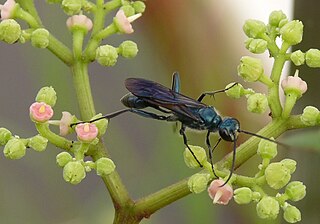
Chalybion is a genus of blue mud dauber wasps in the family Sphecidae. Chalybion species nest in a wide range of natural and artificial cavities such as holes in wood, walls, plant stems, etc., where they typically provision their brood cells with paralyzed spiders. They also reuse old nests of other wasps like Trypoxylon and Sceliphron.

Episyron is a genus of wasps in the family Pompilidae which prey on spiders. Nine species are found in Europe.

The Pompilinae are a subfamily of the spider wasp family, Pompilidae, the species of which lay their eggs on the paralysed bodies of their prey.

Anoplius is a genus of spider wasps in the family Pompilidae, called the blue-black spider wasps.

The Pepsinae are a subfamily of the spider wasp family, Pompilidae, including the tarantula hawks, as well as smaller species.
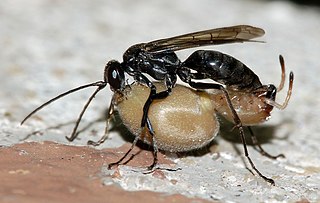
Auplopus is a large genus of spider wasps belonging to the subfamily Pepsinae of the spider wasp family Pompilidae, distributed throughout the world except for Antarctica. Auplopus wasps have the gruesome habit of amputating the legs of their spider prey before transporting it to the nest.
The Ctenocerinae are a subfamily of spider wasps, Pompilidae, which contains a small number of genera, two in the Neotropics, four in Australia and the remainder in Africa. Ctenocerine wasps have evidently evolved from a common ancestor with the Pepsinae, but are specialized for preying upon trap-door spiders (Ctenizidae).
Homonotus is a genus of spider hunting wasps with an old world distribution, mainly in Africa.
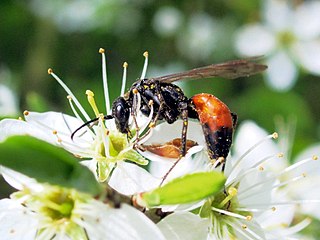
Priocnemis is a genus of pepsine spider wasp containing around 30 species.

Batozonellus a genus of the spider hunting wasps.
Paracyphononyx is a genus of spider wasps distributed in the tropics and warmer temperate regions; they differ from other pompilids in that they do not permanently disable the host spider but allow the spider to resume activity after the wasp has laid its egg on the spider while the wasp larva exists as koinobiont ectoparasitoid of the spider.
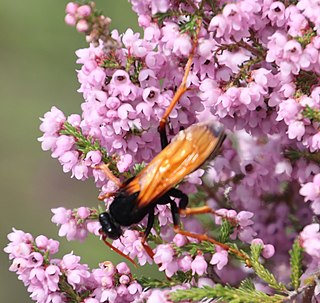
Hemipepsis is a genus of large pepsine spider wasps found throughout the tropics. They are commonly known as tarantula hawks. Hemipepsis wasps are morphologically similar to the related genera Pepsis and Entypus, but distinguishable by the pattern of wing venation. In South Africa 18 plant species from three plant families, the Apocynaceae, Orchidaceae, and Asparagaceae subfamily Scilloideae are pollinated exclusively by Hemipepsis wasps.
Pseudopompilus is a small genus of spider wasps in the subfamily Pompilinae and the tribe Psammoderini. which are found in southern Europe, the Middle East and southern Africa.
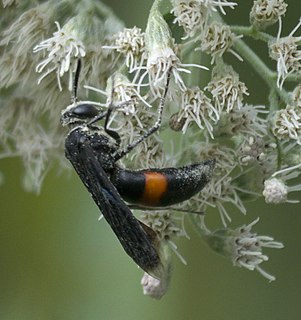
Stizoides is a genus of kleptoparasitic sand wasps in the family Crabronidae. There are at least 30 described species in Stizoides.
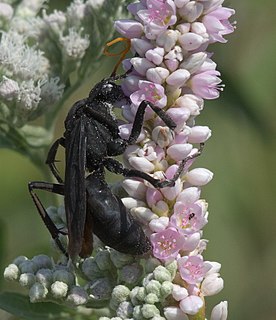
Entypus is a genus of spider wasps in the family Pompilidae. There are at least 40 described species in Entypus.

Pepsini is a tribe of spider wasps in the family Pompilidae.
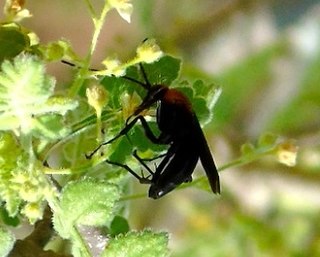
Notocyphus is a genus of spider wasps, belonging to the family Pompilidae. They are the only genus in the monotypic subfamily Notocyphinae. These wasps are found in the Nearctic and the Neotropics.















